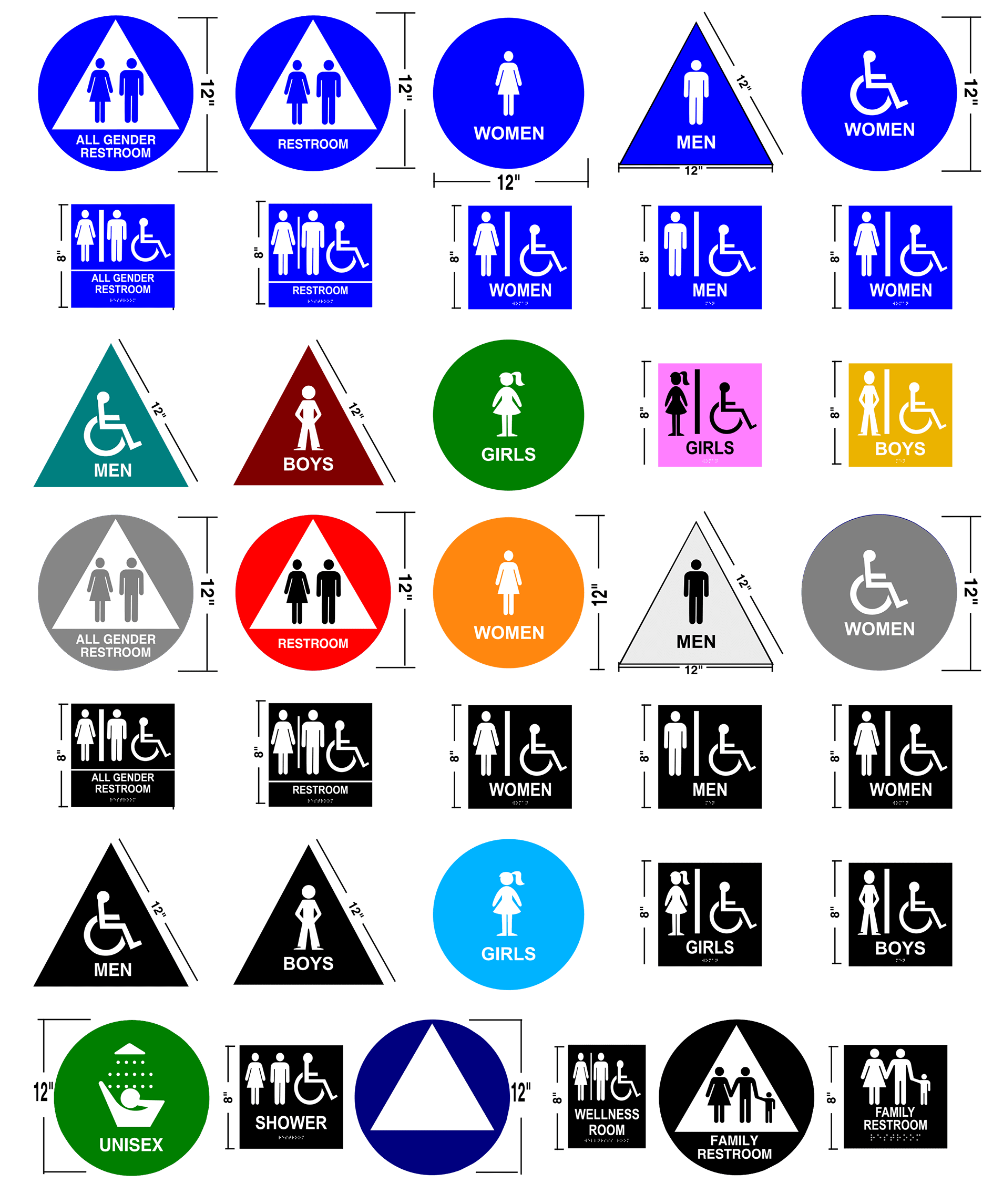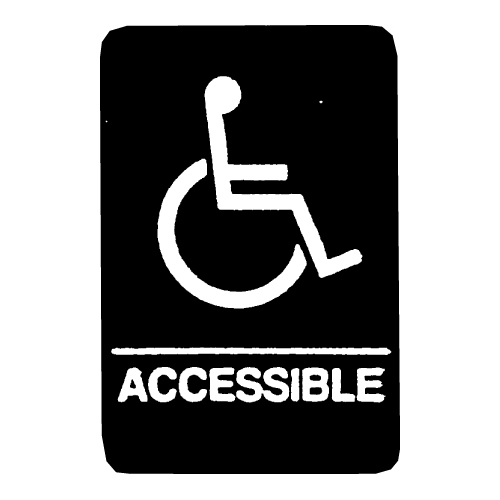Understanding the Regulations Behind ADA Signs
Understanding the Regulations Behind ADA Signs
Blog Article
Discovering the Secret Features of ADA Indications for Enhanced Availability
In the realm of access, ADA indications offer as silent yet powerful allies, making sure that rooms are navigable and comprehensive for people with specials needs. By incorporating Braille and tactile components, these indications damage obstacles for the aesthetically impaired, while high-contrast shade systems and clear typefaces satisfy diverse visual demands. Their strategic placement is not approximate however rather a calculated initiative to facilitate smooth navigating. Beyond these features exists a deeper narrative regarding the development of inclusivity and the recurring dedication to creating equitable spaces. What extra could these indications represent in our pursuit of global accessibility?
Value of ADA Conformity
Ensuring conformity with the Americans with Disabilities Act (ADA) is crucial for cultivating inclusivity and equivalent accessibility in public spaces and offices. The ADA, established in 1990, mandates that all public facilities, employers, and transport services fit people with specials needs, ensuring they appreciate the exact same rights and chances as others. Conformity with ADA standards not only meets legal responsibilities yet additionally improves an organization's track record by showing its commitment to diversity and inclusivity.
One of the crucial elements of ADA compliance is the application of accessible signs. ADA indicators are made to make certain that people with disabilities can easily navigate with structures and rooms.
In addition, adhering to ADA laws can mitigate the danger of possible penalties and legal effects. Organizations that fail to abide by ADA standards may encounter suits or penalties, which can be both monetarily difficult and damaging to their public photo. Hence, ADA compliance is important to fostering a fair setting for everybody.
Braille and Tactile Components
The unification of Braille and responsive aspects right into ADA signs symbolizes the concepts of ease of access and inclusivity. These features are critical for individuals who are blind or aesthetically impaired, allowing them to navigate public areas with greater self-reliance and confidence. Braille, a tactile writing system, is important in offering created information in a style that can be conveniently perceived via touch. It is usually placed under the matching message on signage to make sure that people can access the information without aesthetic aid.
Responsive elements extend beyond Braille and include elevated characters and icons. These components are made to be discernible by touch, enabling individuals to determine area numbers, washrooms, departures, and various other critical locations. The ADA sets specific standards relating to the dimension, spacing, and placement of these responsive elements to maximize readability and make certain consistency throughout different atmospheres.

High-Contrast Color Pattern
High-contrast color plans play a crucial role in enhancing the visibility and readability of ADA signs for people with aesthetic problems. These schemes are essential as they maximize the distinction in light reflectance in between message and background, making certain that signs are quickly discernible, also from a distance. The Americans with Disabilities Act (ADA) mandates making use of particular color contrasts to fit those with limited vision, making it a crucial facet of conformity.
The effectiveness of high-contrast shades exists in their capability to stand out in different lighting problems, consisting of poorly lit atmospheres and locations with glow. Generally, dark text on a light background or light text on a dark background is used to attain optimal contrast. Black message on a yellow or white background provides a stark aesthetic distinction that aids in quick recognition and understanding.

Legible Fonts and Text Dimension
When considering the style of ADA signage, the choice of legible Homepage typefaces and ideal message dimension can not be overemphasized. These elements are critical for making sure that indicators come to individuals with visual impairments. The Americans with Disabilities Act (ADA) mandates that fonts should be sans-serif and not italic, oblique, script, extremely attractive, or of uncommon kind. These demands help guarantee that the text is conveniently readable from a distance which the personalities are distinct to varied target markets.
According to ADA guidelines, the minimal message height should be 5/8 inch, and it needs to enhance proportionally with seeing distance. Consistency in text dimension contributes to a natural visual experience, helping individuals in browsing settings successfully.
Furthermore, spacing in between lines and letters is essential to readability. Appropriate spacing prevents personalities from showing up crowded, enhancing readability. By sticking to these criteria, designers can significantly improve ease of access, making certain that signage serves its desired purpose for all individuals, regardless of their aesthetic capabilities.
Efficient Positioning Strategies
Strategic positioning of ADA signage is necessary for maximizing availability and guaranteeing conformity with legal criteria. ADA guidelines stipulate that indications must be placed at an elevation between 48 to 60 inches from the ground to guarantee they are within the line of sight for both standing and seated individuals.
In addition, signs need to be placed surrounding to the latch side of doors to permit simple identification before entrance. Consistency in indication placement throughout a center enhances predictability, reducing complication and improving general customer experience.

Final Thought
ADA signs play a crucial duty in promoting ease of access by incorporating functions that attend to the requirements of individuals with impairments. Including Braille and responsive aspects makes certain vital details is accessible to the visually impaired, while high-contrast color design and clear sans-serif font styles boost presence across different lights problems. Effective placement techniques, such as proper mounting elevations and strategic locations, even more promote navigation. These aspects jointly cultivate an inclusive atmosphere, highlighting the relevance of ADA conformity in making certain equal access for all.
In the realm of accessibility, ADA indicators offer as quiet yet powerful allies, guaranteeing that spaces are inclusive and accessible for individuals with impairments. look these up The ADA, passed in 1990, mandates that all public facilities, companies, and transportation services suit individuals with disabilities, ensuring they delight in the exact same why not find out more civil liberties and opportunities as others. ADA Signs. ADA signs are made to make sure that individuals with specials needs can conveniently browse with buildings and rooms. ADA standards state that signs need to be installed at an elevation between 48 to 60 inches from the ground to guarantee they are within the line of sight for both standing and seated people.ADA indicators play a crucial role in advertising ease of access by incorporating features that resolve the requirements of people with impairments
Report this page